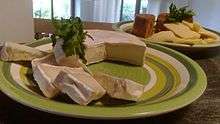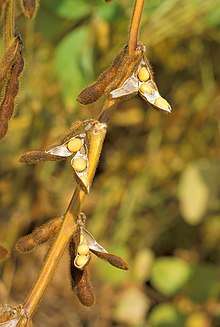Vegan cheese
Vegan cheese is a category of non-dairy, plant-based cheese analogues. Vegan cheeses range from soft fresh cheeses to aged and cultured hard grateable cheeses like plant-based Parmesan. The defining characteristic of vegan cheese is the exclusion of all animal products.[1]

Vegan cheese can be made from various plant proteins and fats. As with plant milk, vegan cheese can be made from seeds, such as sesame and sunflower; nuts, such as cashew,[2] pine nut, and almond;[3] and soybeans, peanuts, coconut oil, nutritional yeast, tapioca,[4] and rice, among other ingredients.
History
Non-dairy cheese originated from China in the 16th century, made with fermented tofu or whole soy.[5]
Later homemade vegan cheeses were made from soy flour, margarine, and yeast extract. With harder margarine, this can produce a hard vegan cheese that can be sliced; softer margarine produces a softer, spreadable cheese.[6]
The product became commercially available around the 1970s or 1980s.[7] These initial products were lower in quality than dairy cheese or today's vegan cheese, with a waxy, chalky or plastic-like texture.[7]
In the early 1990s, the only brand of vegan cheese available in the United States was Soymage.[8] Since then, the number and types (i.e. mozzarella, cheddar, etc.) of widely available vegan cheeses have diversified.[7][8] Also, soy-free options have since been explored. In the 1990s, vegan cheese sometimes cost twice as much as dairy cheese.[6]
Market
As of 2018, the market for vegan cheese grew on a global scale. According to market research, Europe had the greatest market share of 43%, followed by North America, Asia-Pacific, South America and Middle East & Africa.[9] The global vegan cheese market is expected to attain a market value of $3.9bn by the end of 2024, up from $2.1bn in 2016.[10]
According to the Plant Based Food Association, the US market for plant-based foods is anticipated to reach $4 billion in sales by 2024.[11] The expansion is driven by the increased inclination towards vegetarian sources, rising urban populations, and greater preference towards international foods.[12][13] Multiple grocery chains expanded their geographical presence within specialty stores and supermarkets to address the anticipated growth for vegan cheeses, with annual sales growth expected at 8%.[9]
The more common types of vegan cheese being manufactured, distributed, and produced through this market are Mozzarella, Parmesan, Cheddar, Gouda, and Cream Cheese non-dairy based cheeses. These vegan cheeses are consumed in restaurants, grocery stores, bakeries, vegan school meals, and in homes. Vegan cheeses are expected to grow and diversify into the mid-2020s.[14][15]
Vegan cheese is generally more expensive than dairy cheese for consumers.[16]
Labeling
Labeling of vegan cheese, like other vegan dairy analogues, is controversial, with dairy industry groups pushing to prohibit the use of terms like "cheese" on non-dairy products.[17]
In February 2019, a Vancouver, British Columbia vegan cheese shop was ordered by the Canadian Food Inspection Agency (CFIA) to stop calling their products cheese as it was 'misleading' to consumers, despite the store stating that their cheese was always labeled as "dairy-free" and "plant-based."[18] The CFIA later reversed the rejection and stated there was no objection for using the nomenclature “100% dairy-free plant-based cheese” provided that "it is truthful".[19]
In 2019, a Brixton UK vegan cheese shop was asked by Dairy UK to stop describing products as cheese because it 'misleads shoppers', although the store owners stated their "products were clearly marked as dairy-free."[20]
In 2020, vegan cheese company Miyoko's Creamery filed a lawsuit against the California Department of Food and Agriculture after the department ordered the company to stop using dairy words on its packaging.[21] In 2018, the company was sued in New York in a lawsuit that alleged customers were misled by the label "vegan butter."[22] Company founder Miyoko Schinner is a leading advocate for the free speech rights of vegan foods.[23][24]
Ingredients
Common vegan cheese sources include soy, almond and rice milk, in addition to other milk alternatives.[9] Food scientists use a "blend of gums, protein, solids and fats" to create the mouthfeel and melt of dairy cheese.[25] One vegan cheese product aims to solve this difficulty by making cheese with casein produced by yeast rather than by cows.[26]
In August 2019, Botany International Foods recalled Naturli' and Funky Fields' Organic Spreads after undeclared allergens were found in the contents. The Australian Food Standards Authority reported traces of milk in the form of whey protein.[27]
Nutrition
The nutritional value of vegan cheese varies.[28]
Most vegan cheese contains no cholesterol and less saturated fat than dairy cheese. Most vegan cheese is low in calcium, though the Go Veggie brand has similar calcium content to dairy cheese. Vegan cheese is generally not a good source of protein compared to dairy cheese.[16]
A 1998 study comparing cheddar cheese to one type of vegan cheese found that the vegan cheese had lower calories, fat, and protein, though protein content of dairy cheese varies by type. The vegan cheese had higher riboflavin and Vitamin B12, making it an acceptable replacement for cheddar cheese in terms of those nutrients. On the other hand, the vegan cheese did not provide Vitamin A or Vitamin D, in contrast to cheddar cheese. The vegan cheese was found to be a useful source of calcium, but not as good a source as cheddar cheese.[6]
Vegan cheeses made with nutritional yeast, including some alternatives to Parmesan cheese, may provide Vitamin B12, while other vegan cheeses don't.[16]
Production
Plant-based proteins or vegetable proteins are derived from edible sources of protein, such as soybeans and their milk.[29] The manufacturing process of fermentation is often in use to replicate dairy cheese texture and flavor, as well.[30]
Gallery
.jpg) Assorted vegan cheeses
Assorted vegan cheeses.jpg) A vegan cheese platter
A vegan cheese platter Gnocchi made with vegan cheese
Gnocchi made with vegan cheese
See also
- Almond milk
- Cashew milk
- Coconut milk
- Hemp milk
- Nut milk
- Oat milk
- Pea milk
- Plant milk
- Rice milk
- Soy milk
- Walnut milk
References
- Dixie Mahy, Miyoko Schinner, Artisan Vegan Cheese, Book Publishing Company, 2013, p. v.
- Stepkin, Kay (16 January 2013). "Vegan cheese replaces lingering brie craving: Vegan brie takes just minutes of actual work". Chicago Tribune. Archived from the original on 3 March 2018. Retrieved 3 March 2018.
- Buren, Alex Van (29 March 2018). "What Is Vegan Cheese Exactly—and Should You Be Eating It?". Health. Yahoo!. Archived from the original on 3 April 2018. Retrieved 3 April 2018.
Those looking to emulate the creamy texture and saltiness of real cheese tend to find themselves reaching for cashews, both at restaurants and at home. [...] But several other nuts can be transformed into vegan 'cheese'—what Keenan calls 'nutcheese'—such as almonds and pine nuts, among others.
- Moreau, Elise. "What in the World is Vegan Cheese, Anyway? Can it Actually Replace 'Real' Cheese?". Foodie Buzz. Organic Authority. Archived from the original on 3 April 2018. Retrieved 3 April 2018.
Depending on the brand and recipe that's used, vegan cheese can be made from soy protein (used in shiny, slick, rubbery varieties), solidified vegetable oil (like coconut, palm, or safflower) nutritional yeast, thickening agar flakes, nuts (including cashews, macadamias, and almonds), tapioca flour, natural enzymes, vegetable glycerin, assorted bacterial cultures, arrowroot, and even pea protein.
- Kanner, Ellen (Spring 2019). "The Cult and Culture of Vegan Cheese". Holistic Primary Care. 20 (1): 21-22.
- Lightowler, Helen; Davies, Jill (1 January 1998). "The vegan dairy". Nutrition & Food Science. 98 (3): 153–157. doi:10.1108/00346659810208305. ISSN 0034-6659.
- "The Evolution of Vegan Cheese". Fresh n' Lean. 22 June 2015. Archived from the original on 3 April 2018. Retrieved 3 April 2018.
- Winograd, Jennifer; Winograd, Nathan (15 August 2011). "A Guide to Vegan Cheese". All American Vegan. Archived from the original on 3 April 2018. Retrieved 3 April 2018.
- Research Ltd., Infiniti (2019). "Global vegan cheese market 2019-2023". TechNavio: 129.
- "Global Plant-Based Cheese Market to Reach $3.9 Billion by 2024!". One Green Planet. 29 December 2017. Retrieved 1 July 2020.
- "2018 U.S. Retail Sales Data for Plant-Based Foods". Plant Based Foods Association. Plant Based Foods Association. Retrieved 24 October 2019.
- Research Ltd., Infiniti (2019). "Global vegan cheese market 2019-2023". TechNavio: 129.
- "Artisanal vegan cheese comes into its own". San Francisco Chronicle. Hearst Newspapers. Retrieved 13 November 2019.
- "Vegan Cheese Market 2018 – Global Sales,Price,Revenue,Gross Margin and Market Share - Press Release - Digital Journal". www.digitaljournal.com. Retrieved 6 November 2018.
- "Vegan Cheese Market 2018 | Industry Key Players, Growth, Trends, Analysis & Forecast to 2025". Amazing Newshub. 29 October 2018. Retrieved 6 November 2018.
- "A Guide to Vegan Cheese". Vegetarian Journal (2). 2017.
- Lane, Sylvan (24 January 2020). "Senators ask FDA to crack down on non-dairy milks, cheeses". TheHill. Retrieved 18 April 2020.
- "Vancouver vegan cheese shop told they can no longer use the word 'cheese' in packaging". Global News. Retrieved 18 February 2019.
- "CFIA to permit Blue Heron Creamery to use the word 'cheese' on label | Dished". Daily Hive. Retrieved 25 February 2019.
- "Britain's first all-vegan cheese shop causes a stink as dairy industry demands it changes branding". City A.M. Retrieved 17 February 2019.
- "Vegan company Miyoko's Creamery sues California over labeling restrictions". SFChronicle.com. 7 February 2020. Retrieved 9 February 2020.
- foodnavigator-usa.com. "Miyoko's Kitchen sued over vegan butter labels: 'Products bask in dairy's halo'". foodnavigator-usa.com. Retrieved 9 February 2020.
- foodnavigator-usa.com. "Miyoko's Kitchen sued over vegan butter labels: 'Products bask in dairy's halo'". foodnavigator-usa.com. Retrieved 9 February 2020.
- Simon, Michele (6 December 2018). "Miyoko's Scores Plant-Based Victory in Hometown of Petaluma!". Plant Based Foods Association. Retrieved 9 February 2020.
- Estabrook, Rachel (30 April 2012). "Cracking The Code: Making Vegan Cheese Taste Cheesier". The Salt. NPR. Archived from the original on 3 April 2018. Retrieved 3 April 2018.
But to make a true vegan cheese substitute, you can't use casein. So [Jonathan] Gordon's latest challenge has been to make a cheese that is completely free of animal byproducts but still retains the properties we love about cheese. 'The skill of the formulator is to use exactly the right amounts and blend of gums, protein, solids and fats to get a desirable, cheese-like bite and mouth feel while achieving a realistic melt (this is very difficult),' he tells The Salt. Those gums replace the casein, working as 'emulsifiers'and 'stabilizers' to hold the other ingredients together, according to Crowe. (The other ingredients include a protein base like soy or rice, water, oil, starches, flavors and colors.)
- Messina, Ginny (28 September 2014). "Real Vegan Cheese and Real Nutrition Science". The Vegan RD. Archived from the original on 3 April 2018. Retrieved 3 April 2018.
- "Naturli' and Funky Fields". Food Standards Australia & New Zealand. Food Standards Australia & New Zealand. Retrieved 23 October 2019.
- "Vegan Cheese: New and Improved Versions". Vegetarian Journal (3). 2008.
- Jeske, Stephanie; Zannini, Emanuele; Arendt, Elke K. (1 August 2018). "Past, present and future: The strength of plant-based dairy substitutes based on gluten-free raw materials". Food Research International. 110: 42–51. doi:10.1016/j.foodres.2017.03.045. hdl:10468/7832. ISSN 0963-9969. PMID 30029705.
- "The Vegan Way". scienceandfooducla. 26 September 2017. Retrieved 27 November 2018.
Further reading
- Shurtleff, W.; Aoyagi, A. (2013). History of Cheese, Cream Cheese and Sour Cream Alternatives (With or Without Soy) (1896-2013):: Extensively Annotated Bibliography and Sourcebook. Soyinfo Center. ISBN 978-1-928914-61-7.

